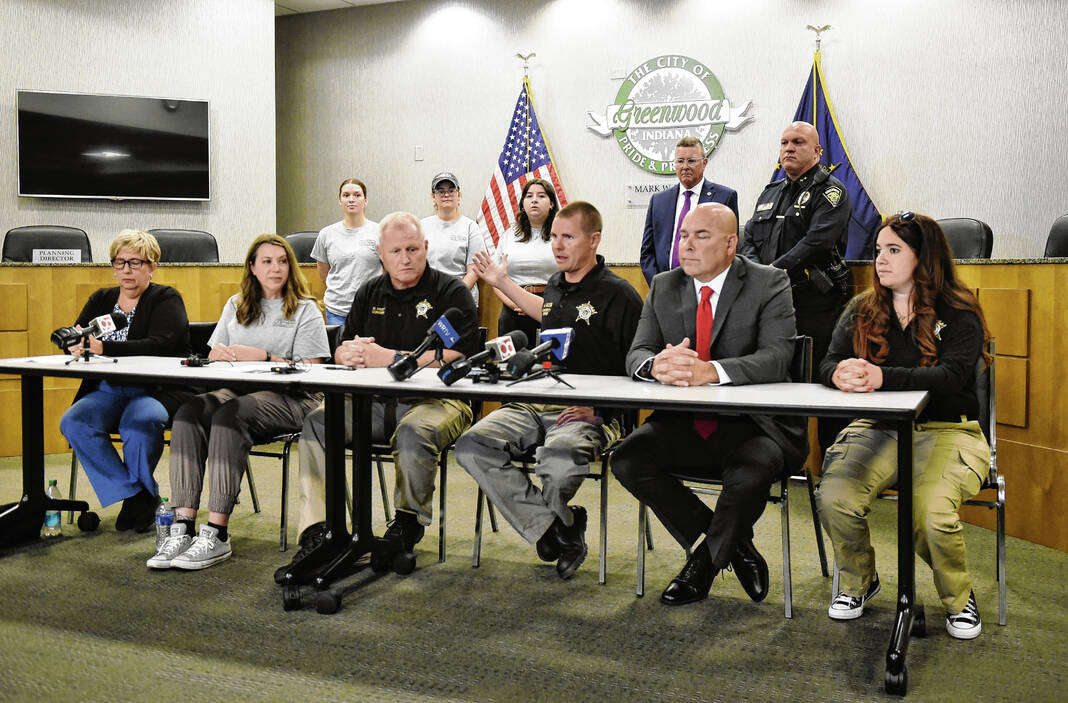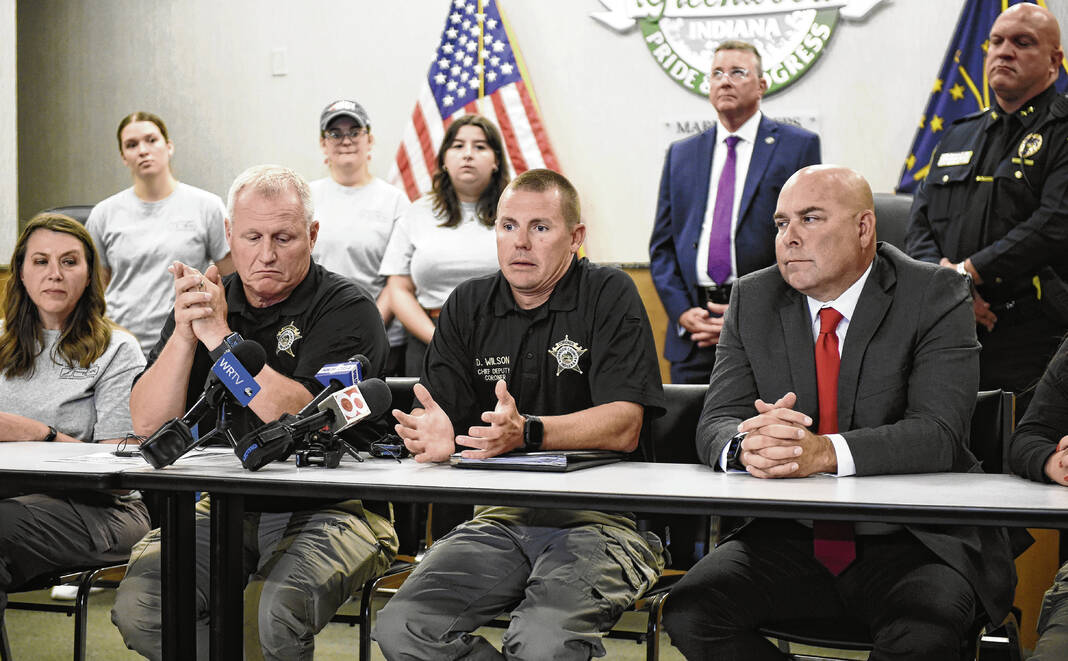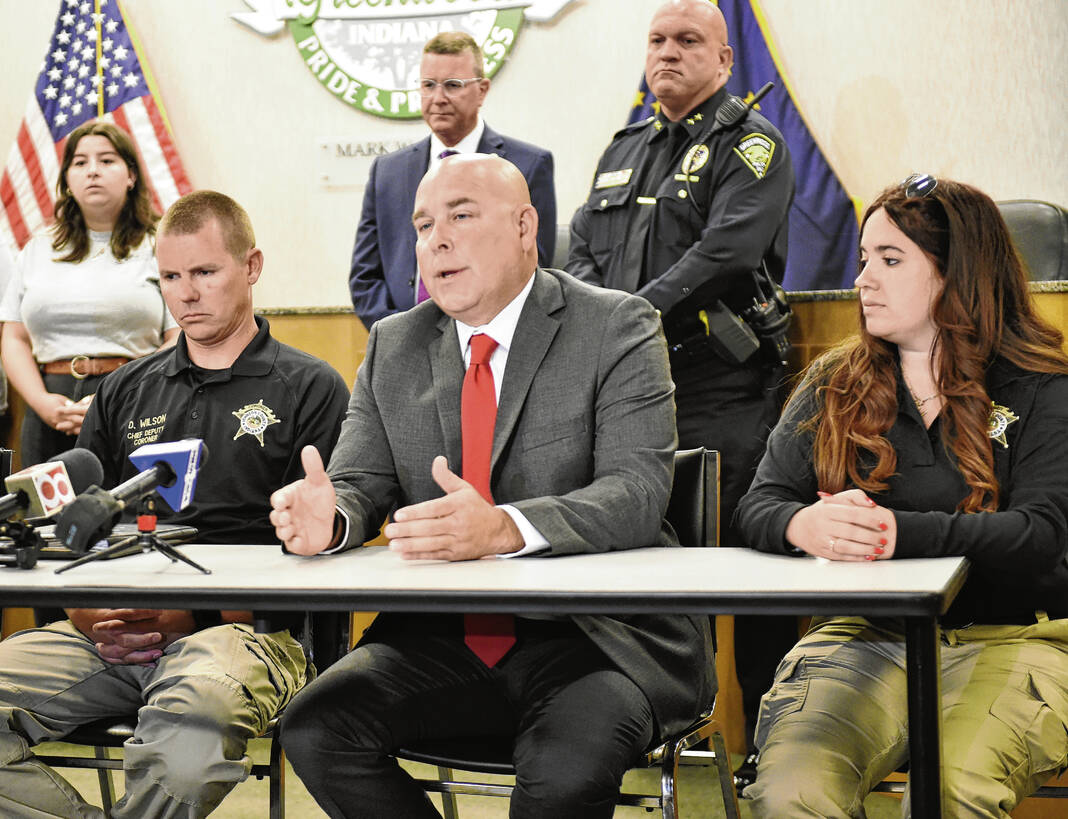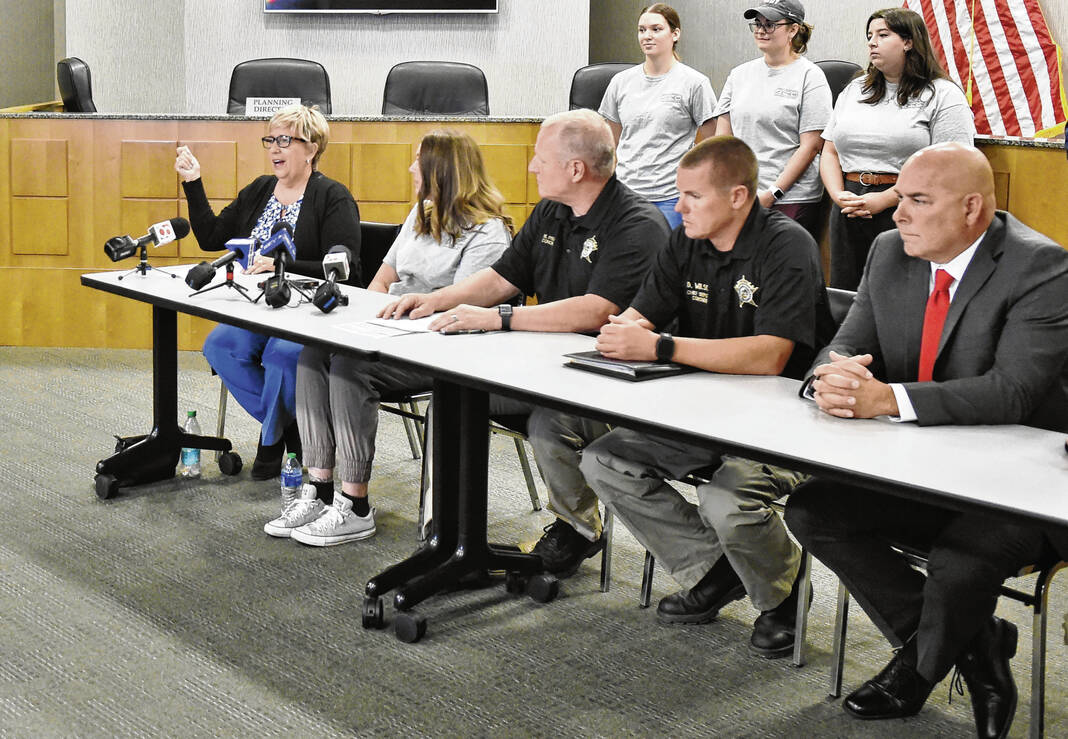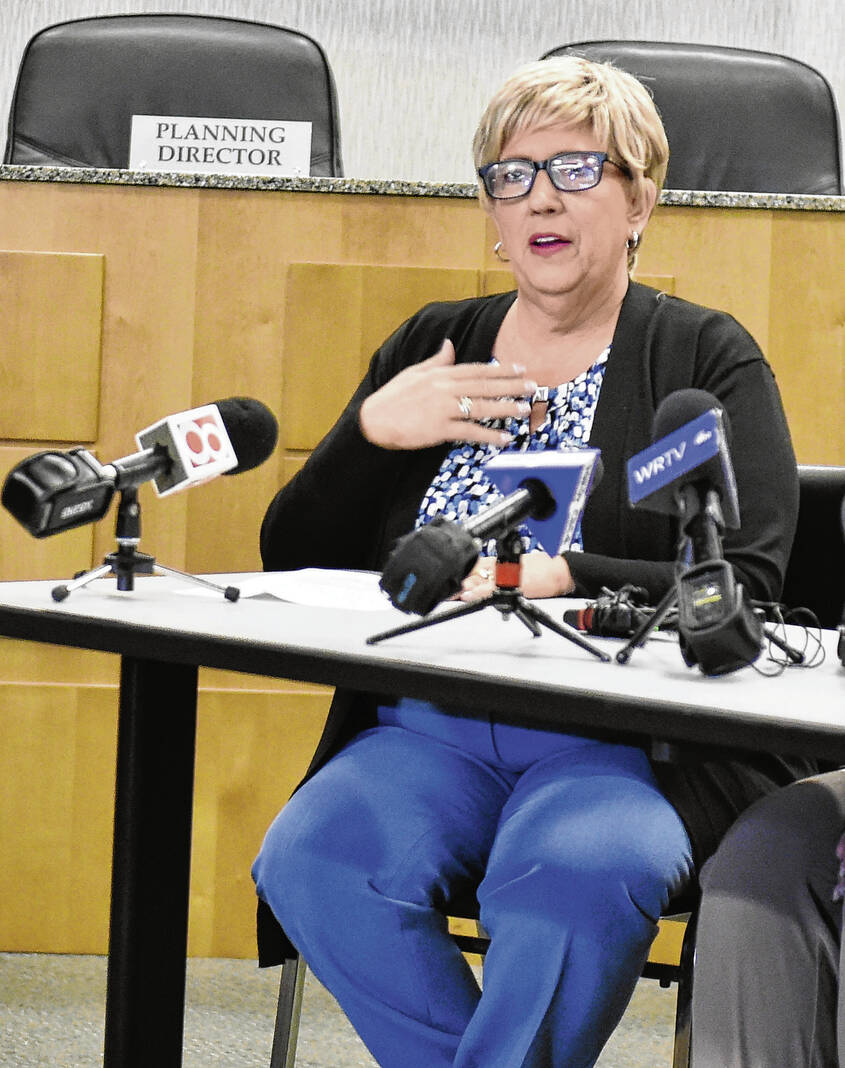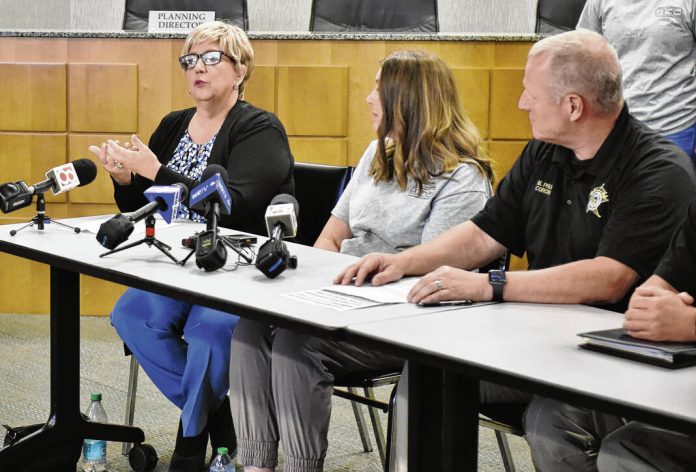
Laurie Pineda, left, first cousin of Michael Benjamin Davis, talks about him during a press conference Thursday at the Greenwood City Center to discuss the identification of Davis’ remains. RYAN TRARES | DAILY JOURNAL
The mystery seemed like it would endure forever.
Human remains had been found in Greenwood in 1993 near Interstate 65. No one knew who the remains belonged to or how to go about finding out. Year after year, investigators added small pieces to the puzzle without seeing the full picture.
Until now.
Investigators have confirmed the remains belong to Michael Benjamin Davis. And though all of the answers have not been given, his family now has a sense of closure.
“For our family to look back at all of the people, through all of the years who were involved in bringing this to us being here today is nothing short of a miracle to us,” said Laurie Pineda, Davis’ first cousin. “It answers our prayers, and it’s a major blessing. We may not know what Michael’s last days were, or how he came to his demise, but we know it’s him now.”
Pineda gathered Thursday with representatives from the Johnson County Coroner’s office, the Greenwood Police Department and the University of Indianapolis for a special press conference to tell the story of how Davis’ remains were identified.
Advances in DNA and genealogical procedures allowed investigators to reopen the cold case, leading them to confirm that the remains were Davis.
“Undoubtedly, forensic genealogy and tree building, things like that, solved this case,” said Derek Wilson, chief deputy coroner for Johnson County.
Johnson County Coroner Mike Pruitt worked in partnership with Greenwood Police, the University of Indianapolis and Othram Forensic DNA Testing Laboratory to identify the remains. Multiple DNA kits used in the case were funded by Crime Junkie Podcast founder and CEO Ashley Flowers, according to the coroner’s office.
Thursday’s event was an opportunity to showcase all of the people, efforts and tools that came together to find the answer of Davis’ remains.
At the same time, it’s a chance to draw attention to the unidentified remains in Indiana and the possibilities new technologies offer.
“The purposes of this briefing today are, one, that we’re getting some closure for Michael’s family. The other part of this is bringing attention to the number of unknown cases out there in Indiana where people have not been positively identified, and urging agencies to use modern technology out there to pursue those,” Pruitt said.
Davis was born in 1965 in Richmond County, South Carolina, before moving with his family to Canada. Family members called him “Benny,” and Pineda remembers him as a sweet and silly kid.
One of Pineda’s favorite stories about her cousin was during a visit he made back in South Carolina when they were both 8 years old. They were all swimming together, and a portion of her swimsuit bottoms came down.
Davis thought it was hilarious.
“He started giggling and laughing, laughing for days. Any time I’d see him, it would be, ‘Do you remember when your bathing suit almost fell off?’” she said.
But Davis suffered from mental health issues throughout his young life, Pineda said. The last time the family heard from him was in 1988, when he was in California. In that conversation, he sounded happy, saying how he had been ordained and was preaching to people, Pineda said.
But family later found that he had been arrested for panhandling, and had ended up in the hospital after being assaulted.
His last conversation with his family indicated he was working for a traveling carnival company somewhere in the Midwest.
“For over 30 years, our family has lived with the uncertainty and pain of not knowing what happened to Michael,” Pineda said.
The bridge connecting the remains found in Greenwood with Davis started in late 1991 or early 1992, said Aaron Hagist, deputy chief of investigations for the Greenwood Police Department.
Children who were playing in the cornfield on land that is now Otte Golf & Family Fun Center first found bones in the field, but believed they were from an animal. When children found additional bones in 1993, it became clear these were human remains, and the police were called.

Some of the remains were found in a shallow grave in the cornfield about 300 feet from I-65. More bones were found scattered around the field as investigators searched the area, according to Daily Journal archives. An examination by experts at the University of Indianapolis and Indiana University found the bones had been decomposing for about two years, archive reports say.
Greenwood Police publicized the discovery with Crimestoppers and put information on an FBI unsolved crime database. Though they received many tips and interviewed 15 to 20 possible suspects, the case has remained unsolved, according to an archive story reported one year after the remains were discovered.
“We did all of the investigating we could, but because these were unknown remains, the case quickly went cold,” Hagist said.
Every few years, another detective would pick up the case, Hagist said.
At their behest, forensic anthropologists with the University of Indianapolis continued to test and search for an answer. The university’s Human Identification Center, which provides expert forensic anthropology consulting services for agencies to identify unknown remains, continued to work on the case.
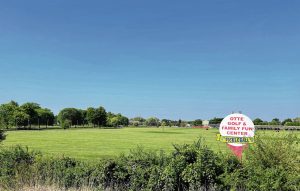
“All forensic tools have their strengths and their limitations. If that wasn’t the case, all of these would be solved immediately. But we do have long-term unidentified cases, and we have a lot in the state of Indiana. Part of that has to do with limitations in technology, part of that has to do with the condition of the remains we’re trying to identify,” Dr. Krista Latham, a forensic anthropologist at the university. “That’s what happened with this case.”
Advances in DNA examination brought incremental progress, but not enough to make an ID. Investigators would send off samples to different agencies hoping for answers, but nothing conclusive ever came.
That changed in April of 2023. A sample sent to Othram, a leading forensic sequencing laboratory for law enforcement, came back with a report suggesting individuals investigators should contact.
Hagist met with Pruitt and Valerie Castro, administrative deputy coroner, to plan how to proceed.
“No one ever said this was an unsolvable case, but [we were] told numerous times this would be a difficult one,” Wilson said.
After months of emails, phone calls, and assistance from other law enforcement agencies across the U.S. and Canada, the coroner’s office was able to locate potential family members, Pruitt said.
The next challenge was reaching out to those people to get a DNA sample. Family members were hesitant at first, not believing the calls to be legitimate. But after multiple conversations, they were able to convince the family their intentions were pure.
“While that call was happy, it was a shock. We never expected a call like this. We were hopeful, but still not sure,” Pineda said. “He needed to get DNA from family members to be sure.”
The field was narrowed with positive DNA results and genealogy tracking located immediate family members. DNA kits were mailed out using funding provided by Flowers.
After nearly six months, Davis’ identification was confirmed.
Pineda will be transporting the remains with her back to South Carolina, where Davis will be buried next to his mother, she said.
“Michael’s [case] is a reminder of the many people who slip through the cracks in our society, who face battles that we may never fully understand,” Pineda said. “While we many never know the details of his final days, we’re grateful to be here today.”
Getting closure on the case has been a relief to all involved in finding answers.
But questions surrounding Davis’ death remain.
The case has long been a suspected homicide, Hagist said. Circumstances surrounding the case, including the location of the remains in a shallow grave in a farm field off the interstate, lead investigators to believe it is more likely than not to be a homicide. However, the cause and manner of death remain undetermined unless more information is discovered.
Local officials hope to use the Thursday announcement as a platform to potentially generate new leads to help move the investigation forward.
“This is the time, if anyone has any information, I’m willing to follow up on anything and take this as far as I can take it. Ideally, I’d love to walk in Michael’s shoes for the last few years of his life, but if I can just get the last few months, that’s information I’d love to have,” Hagist said.
Anyone with additional information about the case is urged to call the Greenwood Police Department at 317-882-9191.


